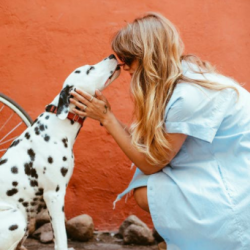
When my dog was a puppy, she liked to chase after skunks in the area where we would walk her. As most puppies do, she would begin to chase this unknown creature and keep going until she either caught it or it hurt her. For some reason around her 6th month, this behavior changed. Instead of chasing after skunks, she began to bark and then cower in the corner of the yard.
At first, I did not understand what was going on with my once cuddly puppy. I considered her just being protective of her yard and just scared of the unknown predator that was lurking out there in the darkness. Little did I know that there was a possible medical problem associated with her actions.
At that point, I decided to take her to the vet for an exam. The vet questioned me as to why she appeared to be so afraid of the darkness. I explained that it was probably because she was never exposed to the skunk and that maybe she was never completely trained not to chase the pests out of the yard.
The vet recommended that I speak with a local dog trainer. I got in contact with a trainer for a consultation and learned that the real problem might be separation anxiety. I wasn’t the only dog owner that came in contact with this behavior. Many of us have owned dogs that act like my little puppy did, and they have been found to have separation anxiety.
A dog that has separation anxiety will become overly attached to its owner. If the owner leaves, the dog becomes upset and will chew on the furniture, bark all day, or howl until they are ready to be alone. This is a problem that needs to be addressed, and done so in a gentle way.
When I brought fetched to the trainer, she suggested that I use Kongs as a way to teach my dog that I was leaving the house. The Kong toy can be stuffed with a treat that is small enough to get by the dog’s muzzle andTeaching the dog to go after the treat and bark when it gets close to it is a process that takes time.
While working on this, I would put treats in the pockets of my clothes and place it all over the house so that the dog had to sniff it to believe that it was there. It’s a bit like Pavlov without the bell. Eventually, I would just show the Kong to the dog and after a few tries, the treats would appear. I would then give her a treat and praise her for being such a good girl.
Eventually, the treats were removed and the dog would start approaching the Kong to get her treats. Now, when she gets near it, just give her the treat and praise her for being such a good girl. It’s really important to let them know that when they behave well, they get a treat.
In my years as a dog trainer, I have seen many dogs come through our doors that every time their owner gets ready to leave, the dog would hunch down and try to get closer to the exit door. We would all laugh and say, “Hey, isn’t she going to make that great escape ever?”
I recently watched a video on You Tube from a engineer structural channel that had some 18,000 people showing a Springer Spaniel how to get out of the crate on a routine basis. Not one of the owners had proper knowledge on how to do this. They would make the dog stay longer inside the crate than was necessary.
You would think that this would be easy, yet, not all dogs know how to pass through an invisible or electric fence, let alone how to avoid being hit by a car!
In the video, the dog needs to go into the kennel at a certain time while on a leash. Once the dog is accustomed to passing through the kennel at that time, the owner can dispense with the leash and the dog will stay inside until time to go out.
Many people think that the best way to train a dog is from top to bottom, but this does not answer the question of how to stop a dog from digging under the fence.
One way to solve this is to see if it is possible to get another fence 120 feet up around the kennel area. If this is impossible, see whether or not there are any electronic or invisible dog fences within that area.
The new systems are much more effective than the old systems because they are more precise. They are so sensitive that they can tell when a human is nearby and when the dog is not.
This type of fence is not for everyone, as it does have some disadvantages. Besides that, there are alternatives to these items such as the traditional single, or even double drape house.
You have the option of putting in a top, which has been there for years.

